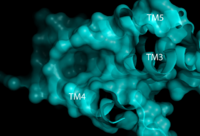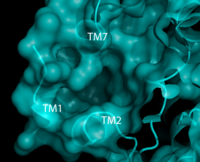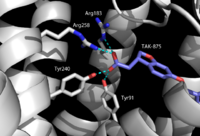Sandbox Reserved 1170
From Proteopedia
(Difference between revisions)
| Line 13: | Line 13: | ||
=== Charge Network === | === Charge Network === | ||
| - | [[Image:hydrogen bonding black.png|200 px|right|thumb|Figure 3. TAK-875 with key binding residues Tyr91, Arg183, Tyr240, and Arg258. These residues all hydrogen bond to the carboxylate moiety of TAK-875.]]hGPR40 has a distinct binding pocket that is established by <scene name='72/721541/All_binding_residues/3'>eight key residues</scene>: <scene name='72/721541/Tyr91/1'>Tyr91</scene>, <scene name='72/721541/Glu172/2'>Glu172</scene>, <scene name='72/721541/Arg183/2'>Arg183</scene>, <scene name='72/721541/Ser187/2'>Ser187</scene>, <scene name='72/721541/Tyr240/1'>Tyr240</scene>, <scene name='72/721541/Asn241/1'>Asn241</scene>, <scene name='72/721541/Asn244/1'>Asn244</scene>, and <scene name='72/721541/Arg258/1'>Arg258</scene> (all individual residues shown in <FONT COLOR="#00FF00">chartreuse</FONT>). The importance of these residues for agonist binding was determined by alanine [https://www.neb.com/applications/cloning-and-synthetic-biology/site-directed-mutagenesis mutagenesis] studies. Each of these residues have either a [http://www.proteinstructures.com/Structure/Structure/amino-acids.html charged or polar R-group] that creates a charge network that keeps these residues in a stable, unbound state until exposed to a substrate. When the substrate (an agonist) enters the binding pocket, four of the eight <scene name='72/721541/Hydrogen_binding_1/8'>key binding residues</scene> interact directly with the carboxylate moiety of the agonist by hydrogen bonding to it. These residues include two key arginines in the binding pocket, Arg183 and Arg258,<ref name="Sum">PMID: 17699519</ref><ref name="Sum, C.">PMID:19068482</ref> and two key tyrosine residues, Tyr91 and Tyr240 (Figure 3). Tyr240 is especially important for binding, as mutation of Tyr240 caused an eight fold reduction in the binding affinity of TAK-875 and had a significant effect on the [https://en.wikipedia.org/wiki/Dissociation_constant K<sub>D</sub>] of the protein.<ref name="Srivastava"/> | + | [[Image:hydrogen bonding black.png|200 px|right|thumb|Figure 3. TAK-875 with key binding residues Tyr91, Arg183, Tyr240, and Arg258. These residues all hydrogen bond to the carboxylate moiety of TAK-875.]]hGPR40 has a distinct binding pocket that is established by <scene name='72/721541/All_binding_residues/3'>eight key residues</scene>: <scene name='72/721541/Tyr91/1'>Tyr91</scene>, <scene name='72/721541/Glu172/2'>Glu172</scene>, <scene name='72/721541/Arg183/2'>Arg183</scene>, <scene name='72/721541/Ser187/2'>Ser187</scene>, <scene name='72/721541/Tyr240/1'>Tyr240</scene>, <scene name='72/721541/Asn241/1'>Asn241</scene>, <scene name='72/721541/Asn244/1'>Asn244</scene>, and <scene name='72/721541/Arg258/1'>Arg258</scene> (all individual residues shown in <FONT COLOR="#00FF00">'''chartreuse'''</FONT>). The importance of these residues for agonist binding was determined by alanine [https://www.neb.com/applications/cloning-and-synthetic-biology/site-directed-mutagenesis mutagenesis] studies. Each of these residues have either a [http://www.proteinstructures.com/Structure/Structure/amino-acids.html charged or polar R-group] that creates a charge network that keeps these residues in a stable, unbound state until exposed to a substrate. When the substrate (an agonist) enters the binding pocket, four of the eight <scene name='72/721541/Hydrogen_binding_1/8'>key binding residues</scene> interact directly with the carboxylate moiety of the agonist by hydrogen bonding to it. These residues include two key arginines in the binding pocket, Arg183 and Arg258,<ref name="Sum">PMID: 17699519</ref><ref name="Sum, C.">PMID:19068482</ref> and two key tyrosine residues, Tyr91 and Tyr240 (Figure 3). Tyr240 is especially important for binding, as mutation of Tyr240 caused an eight fold reduction in the binding affinity of TAK-875 and had a significant effect on the [https://en.wikipedia.org/wiki/Dissociation_constant K<sub>D</sub>] of the protein.<ref name="Srivastava"/> |
=== ECL2 === | === ECL2 === | ||
Revision as of 19:56, 13 April 2016
Human GPR40 (hGPR40), also known as Free Fatty Acid Receptor 1 (FFAR1)
| |||||||||||
References
- ↑ 1.0 1.1 1.2 1.3 1.4 1.5 1.6 1.7 1.8 Srivastava A, Yano J, Hirozane Y, Kefala G, Gruswitz F, Snell G, Lane W, Ivetac A, Aertgeerts K, Nguyen J, Jennings A, Okada K. High-resolution structure of the human GPR40 receptor bound to allosteric agonist TAK-875. Nature. 2014 Jul 20. doi: 10.1038/nature13494. PMID:25043059 doi:http://dx.doi.org/10.1038/nature13494
- ↑ Morgan NG, Dhayal S. G-protein coupled receptors mediating long chain fatty acid signalling in the pancreatic beta-cell. Biochem Pharmacol. 2009 Dec 15;78(12):1419-27. doi: 10.1016/j.bcp.2009.07.020., Epub 2009 Aug 4. PMID:19660440 doi:http://dx.doi.org/10.1016/j.bcp.2009.07.020
- ↑ Kebede M, Ferdaoussi M, Mancini A, Alquier T, Kulkarni RN, Walker MD, Poitout V. Glucose activates free fatty acid receptor 1 gene transcription via phosphatidylinositol-3-kinase-dependent O-GlcNAcylation of pancreas-duodenum homeobox-1. Proc Natl Acad Sci U S A. 2012 Feb 14;109(7):2376-81. doi:, 10.1073/pnas.1114350109. Epub 2012 Jan 30. PMID:22308370 doi:http://dx.doi.org/10.1073/pnas.1114350109
- ↑ Ma Z, Lin DC, Sharma R, Liu J, Zhu L, Li AR, Kohn T, Wang Y, Liu JJ, Bartberger MD, Medina JC, Zhuang R, Li F, Zhang J, Luo J, Wong S, Tonn GR, Houze JB. Discovery of the imidazole-derived GPR40 agonist AM-3189. Bioorg Med Chem Lett. 2016 Jan 1;26(1):15-20. doi: 10.1016/j.bmcl.2015.11.050., Epub 2015 Nov 17. PMID:26620255 doi:http://dx.doi.org/10.1016/j.bmcl.2015.11.050
- ↑ 5.0 5.1 5.2 5.3 5.4 Burant CF. Activation of GPR40 as a therapeutic target for the treatment of type 2 diabetes. Diabetes Care. 2013 Aug;36 Suppl 2:S175-9. doi: 10.2337/dcS13-2037. PMID:23882043 doi:http://dx.doi.org/10.2337/dcS13-2037
- ↑ Hong YH, Nishimura Y, Hishikawa D, Tsuzuki H, Miyahara H, Gotoh C, Choi KC, Feng DD, Chen C, Lee HG, Katoh K, Roh SG, Sasaki S. Acetate and propionate short chain fatty acids stimulate adipogenesis via GPCR43. Endocrinology. 2005 Dec;146(12):5092-9. Epub 2005 Aug 25. PMID:16123168 doi:http://dx.doi.org/10.1210/en.2005-0545
- ↑ Lin DC, Guo Q, Luo J, Zhang J, Nguyen K, Chen M, Tran T, Dransfield PJ, Brown SP, Houze J, Vimolratana M, Jiao XY, Wang Y, Birdsall NJ, Swaminath G. Identification and pharmacological characterization of multiple allosteric binding sites on the free fatty acid 1 receptor. Mol Pharmacol. 2012 Nov;82(5):843-59. doi: 10.1124/mol.112.079640. Epub 2012 Aug , 2. PMID:22859723 doi:http://dx.doi.org/10.1124/mol.112.079640
- ↑ Sum CS, Tikhonova IG, Neumann S, Engel S, Raaka BM, Costanzi S, Gershengorn MC. Identification of residues important for agonist recognition and activation in GPR40. J Biol Chem. 2007 Oct 5;282(40):29248-55. Epub 2007 Aug 15. PMID:17699519 doi:http://dx.doi.org/10.1074/jbc.M705077200
- ↑ Sum CS, Tikhonova IG, Costanzi S, Gershengorn MC. Two arginine-glutamate ionic locks near the extracellular surface of FFAR1 gate receptor activation. J Biol Chem. 2009 Feb 6;284(6):3529-36. doi: 10.1074/jbc.M806987200. Epub 2008, Dec 8. PMID:19068482 doi:http://dx.doi.org/10.1074/jbc.M806987200
- ↑ Itoh Y, Kawamata Y, Harada M, Kobayashi M, Fujii R, Fukusumi S, Ogi K, Hosoya M, Tanaka Y, Uejima H, Tanaka H, Maruyama M, Satoh R, Okubo S, Kizawa H, Komatsu H, Matsumura F, Noguchi Y, Shinohara T, Hinuma S, Fujisawa Y, Fujino M. Free fatty acids regulate insulin secretion from pancreatic beta cells through GPR40. Nature. 2003 Mar 13;422(6928):173-6. Epub 2003 Feb 23. PMID:12629551 doi:http://dx.doi.org/10.1038/nature01478
- ↑ Kaku K, Enya K, Nakaya R, Ohira T, Matsuno R. Efficacy and safety of fasiglifam (TAK-875), a G protein-coupled receptor 40 agonist, in Japanese patients with type 2 diabetes inadequately controlled by diet and exercise: a randomized, double-blind, placebo-controlled, phase III trial. Diabetes Obes Metab. 2015 Jul;17(7):675-81. doi: 10.1111/dom.12467. Epub 2015 Apr, 23. PMID:25787200 doi:http://dx.doi.org/10.1111/dom.12467




